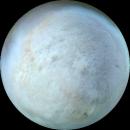For your browsing pleasure:
Iowa State To Have The Most Realistic Virtual Reality Room in the World
More than $4 million in equipment upgrades will shine 100 million pixels on Iowa State University’s six-sided virtual reality room. That’s twice the number of pixels lighting up any virtual reality room in the world and 16 times the pixels now projected on Iowa State’s C6, a 10-foot by 10-foot virtual reality room that surrounds users with computer-generated 3-D images. That means the C6 will produce virtual reality at the world’s highest resolution.
“This rock is basically a battery,” Friedemann Freund says, tapping a 3-foot chunk of granite. To demonstrate his point, he’s placed the rock in a refrigerator-sized steel press and attached wires to copper electrodes on either end. The touch of a button drops 20,000 pounds of pressure on the block, sending a few nanoamps of current through the wires.
His rock battery may be too weak to power a flashlight, but Freund – a white-haired physics professor who divides his time among San Jose State University, the SETI Institute, and NASA – is thinking bigger. Multiply the experiment over a few miles of rock, add the pressure around a seismic fault that’s about to snap, and, Freund figures, you’d get an electric signal that could be used to predict earthquakes.
Via GeekPress
$10M Prize for Hydrogen Fuel Technology
WASHINGTON – Scientists, inventors and entrepreneurs will be able to vie for a grand prize of $10 million, and smaller prizes reaching millions of dollars, under House-passed legislation to encourage research into hydrogen as an alternative fuel.
Legislation creating the “H-Prize,” modeled after the privately funded Ansari X Prize that resulted last year in the first privately developed manned rocket to reach space twice, passed the House Wednesday on a 416-6 vote. A companion bill is to be introduced in the Senate this week.
Scientists explain origin of Neptune’s odd moon
LOS ANGELES, May 10 (Xinhua) — Neptune’s largest moon Triton may have been a member of a binary pair orbiting the Sun before it was trapped by Neptune, scientists reported on Wednesday.
Triton is unique among all the large moons in the solar system because it orbits Neptune in a direction opposite to the planet’s rotation. About 40 percent more massive than the planet Pluto, Triton has an inclined, circular orbit that lies between a group of small inner moons with prograde orbits and an outer group of small satellites with both prograde and retrograde orbits.
According to Craig Agnor at the University of California, Santa Cruz, and Douglas Hamilton at the University of Maryland, a new model involving a three-body gravitational encounter between a binary and a planet may explain the origin of Triton.
